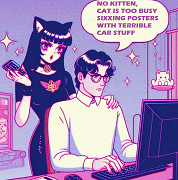|
luminalflux posted:Sweden's longest is apparently longer but fewer cars - 17 cars, 2 locos at 480 meters. Russia's ChS8 trains appear to get just about that length too (I count 17 cars, but I could be wrong): 
|
|
|
|

|
| # ? May 11, 2024 14:11 |
|
Axeman Jim posted:Longest passenger trains in Europe are the Eurostars at 18 cars and 350m. For the US, BART in San Francisco (a metro system) gets to 10 cars and 216m. Amtrak's California Zephyr can get up to 321m with 10 double-decker cars and 3 locos, plus a baggage car. Thats a big passenger train. Think thats about as big as they get in the states, unless one of the single deck Northeast Regionals is maybe longer?
|
|
|
|
Axeman Jim posted:Longest passenger trains in Europe are the Eurostars at 18 cars and 350m. Eurotunnel Passenger Shuttle. Over 800 meters long, they're 2 locomotives, 4 loading / unloading carriages & 24 assorted wagons to carry cars and busses - http://www.eurotunnelgroup.com/uk/the-channel-tunnel/rolling-stock/ e: if we're counting people in cars & coach parties as passengers, that is.
|
|
|
|
Cygni posted:For the US, BART in San Francisco (a metro system) gets to 10 cars and 216m. Amtrak's California Zephyr can get up to 321m with 10 double-decker cars and 3 locos, plus a baggage car. Thats a big passenger train. Not that I know of. Most of the trains I've seen up here are 8 cars. I know the longest MBCR commuter trains are 8 cars. Singles on the north side, and doubles on the south side.
|
|
|
|
iospace posted:So UP is moving a special train down to West Colton to move the Big Boy to Cheyenne. The lead locomotive is UP 4014 and the trailing is UP 4884, the two best to do it with.
|
|
|
|
Shampoo posted:Not that I know of. Most of the trains I've seen up here are 8 cars. I know the longest MBCR commuter trains are 8 cars. Singles on the north side, and doubles on the south side. 
|
|
|
|
Cygni posted:Now that I've looked it up, I think the Empire Builder is actually the biggest (normally) with 10-12 double decker cars as the normal set between Seattle and Chicago. Thats a pretty big passenger train. Actually the biggest is the Auto Train, but that has the added bonus of auto racks at the end. It can run 14-16 passenger cars (all Superliners) and 20-24 auto racks
|
|
|
|
Yeah, I wasn't counting the autotrain cause thats cheatin.
|
|
|
|
Nightstar - Cool name, poo poo train Even as privatisation loomed, British Rail managed one more spectacular burst of idiocy before dying out – this is the story of the ridiculous “Nightstar”, which may possibly hold a record for the most costly train never to actually run. The Channel Tunnel was an engineering triumph, but a financial catastrophe. Fortunately, TML, who managed to deliver the project several years late and £4.5 billion over budget, was not a government folly but a private concern funded mostly by debt - £8 billion of it, to be precise, and when the Chunnel opened for business, the huge servicing costs of the debt, combined with sky-high operating costs, led it to lose an additional £1 billion per year. Eventually the banks swapped their debt for equity, owning the world’s most impressive white elephant. Even now, TML and Eurotunnel bounce in and out of bankruptcy and the tunnel has never run at a profit, or even close to one. Much of the disaster stemmed from massively over-optimistic assessments of traffic levels, failing to forsee the rise of low-cost air travel and more competitive conditions for freight. To this day there are freight paths, guaranteed by international treaty, all over Britain that never run, reserved for Channel Tunnel freight trains that don’t exist. Some of the most congested tracks in the country (such as the strategically vital West London Line) are forced to remain empty by law, with trains held at signals to let legal “ghost trains” pass on the empty tracks. However, British Rail don’t escape from this fiasco unscathed. They were responsible for probably the most ill-conceived Chunnel-related idea of all – “Nightstar”.  No not that one The idea sounded simple enough – provide night-time sleeper services through the tunnel so that it was utilised 24/7, maximising return on investment. The plans that were put in place however, were ludicrous from both an engineering and a financial perspective. The plan envisaged not just a night sleeper from London to Paris, but a huge network spanning much of Western Europe. Trains would run from as far afield as Swansea, Manchester, Plymouth and Glasgow, combining in London in the dead of night and passing through the tunnel in huge convoys, before splitting up again and heading off to Amsterdam, Cologne, Dortmund and Frankfurt. The channel tunnel had extremely exacting regulations for trains, requiring, amongst other things, being able to split in two and reverse out of the tunnel, redundancy of almost every system and the highest crashworthiness specs anywhere on Earth. Many of these have since been relaxed as not only where they expensive and impractical, many of them were counterproductive – long, fortress-like trains proved extremely difficult to evacuate in an emergency. The specs for the “Nightstar” stock given to Alstom were immense. Based on the BR Mk 4, which was a tad overweight to start with, the massive, reinforced carriages were nearly twice the weight per seat as anything else BR had. Their redundant electrical systems (and high degree of internal luxury) required more electrical train supply (ETS) power than any locomotive had ever produced, requiring the effective power output of 100kW (about 125hp) per passenger car. For the Glasgow run, it was decided to use the planned Class 92 electric freight locomotive, which was being created to haul cross-channel freight. The Class 92 was designed not only with the stringent Chunnel requirements, but also to work on 5 different electrical networks of all the nations it would travel in (though in the end they only went as far as Calais as French drivers unions refused to use them). Adding ETS capability drove up their cost and complexity even more. For the non-electrified routes to Swansea and Plymouth, things were even trickier. A plan to buy new diesel locomotives fell through, so BR earmarked some spare Class 37 freight locos for the job. The Class 37 couldn’t produce anywhere near the required ETS index, so separate generator vans were converted from old sleeper stock with 900hp diesel generators to power the trains. So heavy was all this that two class 37s, producing a total of 3500Hp and with a generator car sandwiched between them, would be needed to haul just 7 Nightstar cars from the West to London.  Pictured: The future, or something The Class 92s would be expected to haul 14-car trains from Glasgow to London. The Class 92 was a mighty beast, putting out 6800hp in AC mode, but in DC mode (which would be required from London to Dollands Moor in Kent) they could only manage 5360hp, and that figure is before you deduct 1800hp for two sets worth of ETS, giving them not that much more poke than the Class 37 pairs that were struggling with half the load. The power-to-weight ratios of Nightstar would be more akin to those of heavy freight trains, with performance and timings to match. In fact, one after-the-fact post-mortem of the Nightstar fiasco worked out that, at the time the services were originally planned to start, there was not a single locomotive in all of Europe that could haul a fully-laden 14-car Nightstar set at passenger train speeds. Aside from the engineering problems, there were crippling financial problems too. Sleeper trains are very hard to operate profitably due to their low number of passengers. Especially for the longer-distance services, each passenger would need both a seating berth and a sleeping berth. A 7-car Nightstar set only held 3 cars’ worth of day-train passengers. Combined with the weight and power problems, it was clear that even a fully-loaded Nightstar would lose money hand over fist unless the ticket prices hit four figures. That was a problem when you could hop on an Easyjet flight from Glasgow to Frankfurt for £40 and not spend 18 hours stuck on a train moving at glacial speeds. And just how many people want to travel from Swansea to Dortmund each day anyway? And how many of them would pay £1000 to take a train when that money could buy you a second-hand car and enough petrol to drive there? Plus how are you going to check-in and security-screen passengers at small, regional stations like Plymouth and Swansea, for trains that only left once a day? Where would you put the x-ray machines? Where would you get trained border staff who were willing to only work an hour a day? What was everyone involved smoking? Despite all this, construction of the massively heavy and over-engineered passenger cars continued until 139 of them were completed or nearly completed by the time the programme was abandoned in 1999. The coaches alone had cost £400m, and the Class 37 and generator van conversions, additional costs for the Class 92 programme (including buying more than would end up being needed) as well as general overhead and financing costs pushed the cost of Nightstar up to something like three quarters of a billion pounds. That’s not quite as much as APT cost, but at least the APT resulted in an actual train that they put on an actual track and drove around, not to mention some important technological advances. Nightstar was a complete dead-end. In 2002 the government tried to sell the carriages, but it turned out that not many people were interested in 54-ton sleeper cars, designed for the weird British loading gauge, that needed whole extra locomotives just to power their electrical systems. Eventually VIA Canada bought them for just £90m, a quarter of their value. They are still operating in Canada as “Renaissance” sets, where they have been criticised for their lack of disabled access.  Heeeaaaave! British Rail certainly went out with a bang.
|
|
|
|
Axeman Jim, your posts have been facinating to read. What an utter shitstorm
|
|
|
|
Yeah I'm kinda sad the saga has drawn to a close. Excellent reading these past weeks, every time I see this thread updated I get excited in hopes that it's another axeman jim post.
|
|
|
|
Re: long passenger trains, Pre-Amtrak passenger trains in the US occasionally got really long with extra mail cars or extra coaches when there was a special event that a lot of people wanted to travel to.
|
|
|
|
ijustam posted:There was a video of a freight train stopped in California, right next to a stadium. The train was blocking multiple crossings right as a game was about to start so people started going over/under the train and it looked like a disaster waiting to happen if the brakes were to suddenly come off. It's videos like this that make me almost turn into my dad and start yelling at the screen at all the dumasses.
|
|
|
|
So a pretty huge rail infrastructure project here that should be finished in 2016. http://en.wikipedia.org/wiki/Regional_Rail_Link The Regional Rail Link, is a $5bn grade/line separation project that is designed to give regional trains dedicated tracks into the city from the north and west. Speeding up services is not actually an outcome of this project but because they are no longer held up by the suburban network it allows a higher capacity to run on both the regional and suburban lines. Anyway, they have a neat flyover video of the entire line: Before/After (After being March 2014) video: https://www.youtube.com/watch?v=YcN-eeBGkLA March 2014 video (no split screen): https://www.youtube.com/watch?v=YcN-eeBGkLA
|
|
|
|
Cygni posted:Now that I've looked it up, I think the Empire Builder is actually the biggest (normally) with 10-12 double decker cars as the normal set between Seattle and Chicago. Thats a pretty big passenger train.
|
|
|
|
Elukka posted:Man, how heavy are these things? I'm used to seeing passenger trains invariably pulled by a single electric locomotive. They're never that long here (Finland) but even then how do 10-12 coaches take three locomotives? These are long distance trains unlike the ones you have in Europe (outside of Russia maybe). The trains we run from Chicago to L.A. (Southwest Chief) travel something like 3,600km. Most pictures I've seen of these trains have two locomotives (one for redundancy), I guess in that picture there you have 3 for the extra  factor. factor.But seriously, don't you wanna ride that bitch through the Rocky Mountains? Wicaeed fucked around with this message at 08:11 on Apr 24, 2014 |
|
|
|
The Ghan in Australia uses two NR class diesel electrics to pull it from Adelaide to Darwin and they have variable power GE 7FDL-16 engines, with power levels of 2 850 HP, 3 560 HP or 4 020 HP. Thats a purely passenger train with 2-3 Auto transport carriages.
|
|
|
|
Axeman Jim posted:Nightstar - Cool name, poo poo train All sleepers in the uk have cheaper tickets for seating berth only, and I think that's common on continental trains too. Was Nightstar really planned to do without or have you just simplified for rhetorical effect there? Not that the slight space efficiency would make the difference to this being a bad idea. I'm wondering if people had been working under the assumption that the UK would have joined Schengen after the tunnel opened because a) it's a good idea and we should have done b) it would remove a lot of the non-technical issues you mention like pointless border agency staff.
|
|
|
|
Ferremit posted:The Ghan in Australia uses two NR class diesel electrics to pull it from Adelaide to Darwin and they have variable power GE 7FDL-16 engines, with power levels of 2 850 HP, 3 560 HP or 4 020 HP. Thats a purely passenger train with 2-3 Auto transport carriages. Those Amtrak locos are GE Genesis units, producing 4200 HP apiece on DC, or 3200 AC. I mean, think about that. A potential peak of nearly 13,000 HP pulling that train. Of course, our coaches here in the US have a Nightstar-like weight problem too, due to FRA crashworthiness standards.
|
|
|
|
.
sincx fucked around with this message at 05:55 on Mar 23, 2021 |
|
|
|
sincx posted:Honestly that's not that much. I believe the Eurosprinter has 8000 hp, and those train are probably half the weight. 8600hp actually, not sure of the weight, but it's somewhere in the vicinity of 90 tonnes. The EuroSprinter is a very impressive loco.
|
|
|
|
On the GE locomotives, 1 unit is generally making head end power and the other is making traction power. Also with grades and weight to make track speed you need 2 engines. Its not an american thing... just how it operates.
|
|
|
|
mackintosh posted:8600hp actually, not sure of the weight, but it's somewhere in the vicinity of 90 tonnes. The EuroSprinter is a very impressive loco. Yeah, they are pretty dang cool. Amtrak has a variant of the Eurosprinter for the few electrified lines on the east coast, but nobody is gonna be electrifying the 3,924km Cal Zephyr line between Chicago and Los Angeles, over the Sierra Nevada and Rocky Mountains. Can't even imagine what that would cost, ha.
|
|
|
|
Milwaukee Road actually electrified their transcontinental route in the Rocky's around the turn of the century, but the wire was all torn out in the 70's. It'd be funny if it wasn't so sad. Traffic on their line to Seattle was booming, but they finished electification right as the boom in Seattle ended, and also only a few years before the Panama canal opened, so they could barely fill one train a day in each direction on the line. Then in the 72 they de-energized half their electric line and in 74 the other half (they had two sections, one from Tacoma & Seattle to Othello, Washington, and another from Harlowton, Montana to Avery, Idaho). Right as the oil crisis hit. So basically A+ Milwaukee Road at having the worst possible timing. Though they should have predicted the Panama Canal would have a major impact on shipping.
|
|
|
|
It is worse than that. They tore it out despite everyone telling them it was a bad idea just so that they could sell the copper. (Which had a price drop right when they were selling it.) But wait, there's more. General Electric approached them and told them that they would fund electrifying the rest of the route as opposed to tearing everything out. They were, of course, turned down. In regard to passenger train length in the states we had an interesting practice here if you needed to haul a bunch of passengers to the same location, such as the baseball specials that railroads would run. They were sectional trains where you would have up to and around 5 separate trains, called sections, following each other at certain intervals. Each train in the section, minus the last train, would be displaying the green classification lights to inform other trains that there was a following section. One of the more famous sectional trains was a Reading baseball special heading from Reading, PA down to Philadelphia. Due to a delay at the station, one of the following sections slammed into the section in front of it in 1899 causing the worst train accident on the Reading railroad. An interesting fact about the wreck was that it occurred at Exeter station and during the following weeks, people would take trips out to Exeter in order to get souvenirs and see what they could see. Because of this, Exeter changed its name to Loraine which has only recently been changed back.
|
|
|
|
|
Axeman Jim posted:Much of the disaster stemmed from massively over-optimistic assessments of traffic levels, failing to forsee the rise of low-cost air travel and more competitive conditions for freight. To this day there are freight paths, guaranteed by international treaty, all over Britain that never run, reserved for Channel Tunnel freight trains that don’t exist. Some of the most congested tracks in the country (such as the strategically vital West London Line) are forced to remain empty by law, with trains held at signals to let legal “ghost trains” pass on the empty tracks. Have you got any more details on this? It sounds as comical as the parliamentary trains we have; like the one way, once a week, Stockport to Stalybridge line.
|
|
|
|
JingleBells posted:Have you got any more details on this? It sounds as comical as the parliamentary trains we have; like the one way, once a week, Stockport to Stalybridge line. As I understand it, the theory there is pretty simple: to officially close a line, you're likely to end up with expensive inquiries, court challenges, and so forth that will cost a lot of money. If the line is open, you must have a train running over it once a week at least. Running that train and maintaining the track is cheaper over the period you're calculating than the costs of closure. Plus you never know when you might actually want to use it properly - keeping it available is far cheaper than having to buy back all the land and rebuild from scratch.
|
|
|
|
The Zephyr is about the same length as the Empire Builder and I'm pretty sure it only uses 2 locomotives the entire way. Also remember that Amtrak/VIA withdrew all the Superliners from service in Canada after the crash in 1999
|
|
|
|
https://www.google.com/maps/@35.0269921,-89.8984434,1588m/data=!3m1!1e3 https://www.memphisdailynews.com/news/2010/apr/22/bnsf-opens-new-rail-yard-site-after-finishing-upgrades/ BNSF's Memphis intermodal terminal is everything that I'd want in a terminal. The people that designed it seemed to truly understand the operation, BNSF doesn't seem to have spared any expense in building it, and there is ample room to expand the operation.
|
|
|
|
|
Cerv posted:All sleepers in the uk have cheaper tickets for seating berth only, and I think that's common on continental trains too. Was Nightstar really planned to do without or have you just simplified for rhetorical effect there? A 7-coach Nightstar set would have consisted of 3 sleeper cars, 3 day cars, and a service/restaurant car. So it would have had at most the capacity of the 3 day cars, including anyone dumb enough not to book a bed for a 18-20 hour journey. JingleBells posted:Have you got any more details on this? It sounds as comical as the parliamentary trains we have; like the one way, once a week, Stockport to Stalybridge line. I read it in a report that I think the Transport Research Laboratory did for the DfT in about 2004 - it was on the DfT website somewhere though goodness knows where it is now. It was a report looking at how to increase the capacity of cross-London freight. Basically about 8 paths per day in each direction had been guaranteed by treaty to cross-channel freight traffic and less than half of them were being used. Apparently the chances of re-negotiating the treaty were so low that it didn't even merit serious consideration, and those paths (badly needed by other traffic) had to sit unused. In the end, they recommended routing more freight via the Chertsey/Brentford/Kew/Acton route instead, by doubling and electrifying Kew junction, which I believe is what eventually happened. Brovine is correct about "Parliamentary Trains", though they are different to "Ghost Trains" such as the Chunnel paths because they actually run, at the minimum service level (usually one train a week, one way) to keep the line open. "Ghost Trains" run on busier tracks usually and are services that are timetabled but not advertised, and almost always cancelled, for similar reasons i.e. nobody wants the actual train but they have to timetable a certain number. I used to travel on business to Northampton most weekends and come back to London on the same train on a Sunday afternoon. Almost every time, as we pulled out of Milton Keynes, the guard would come on the intercom and say "because of a fault on this train, this train is being terminated at Bletchley" - which just happened to be where the Class 321 units running the service were maintained. We'd all spill out onto the platform and wait 15 minutes for the next train whilst they reversed the unit into the depot in what was clearly a positioning move for the Monday rush hour, but they had to pretend that the train was broken to explain why they weren't continuing the timetabled run to Euston - which became a "Ghost Train". gently caress you, Silverlink, nobody was fooled.
|
|
|
|
MassivelyBuckNegro posted:https://www.google.com/maps/@35.0269921,-89.8984434,1588m/data=!3m1!1e3 Reminds me of this video, which is pretty cool: https://www.youtube.com/watch?v=GHmyYqfNYnc The railroads know what it takes to make money, and it sounds like they understand that they're in a capital intensive business with only long term payoffs. I'm also reaaaaly glad that Warren Buffet owns BNSF, because he absolutely gets that a rail company is not something you can wring short term profits out of, that it's a long term investment, and one that has to keep investing in itself to keep growing.
|
|
|
|
Mom's dad side worked for the New York Central and mom's mom side worked for the Pennsy. Talk about bad blood for years... I never did get to meet the great grandfathers on either side, but I was told, they were never really on speaking terms for years.
|
|
|
|
BrokenKnucklez posted:
IIRC it was the largest bankruptcy until Enron, but I don't remember where I read that.
|
|
|
|
Wikipedia says that: http://en.wikipedia.org/wiki/Penn_Central_Transportation_Company#Bankruptcy But it sounds like it's been dwarfed now by all the financial bankruptcies, and also possibly inflation, because the Wikipedia article of largest corporate bankruptices and a CNN article I found don't mention anything about inflation adjusted numbers.
|
|
|
|
Yeah, and it depends on if its classified by actual dollars, inflation, or real assets? Either way, the effect it had on the New England economy was devastating. The next bigger crisis was the UP-SP merger in 1996. I don't know the dollar amount, but it was incredible service crisis. Edit: What I find interesting, that the NYC gave "The Commodore" Vanderbilt his wealth, being the second wealthiest man in America (possibly the world) next to Rockefeller. (I think this is disputed by Carnegie's wealth) http://www.nytimes.com/ref/business/20070715_GILDED_GRAPHIC.html As much as I like railroading, the history, the power, and how it pretty much dictated the country. BrokenKnucklez fucked around with this message at 18:30 on Apr 25, 2014 |
|
|
|
FISHMANPET posted:Milwaukee Road actually electrified their transcontinental route in the Rocky's around the turn of the century, but the wire was all torn out in the 70's. I wish the Milwaukee Road didn't close up. Now that's left are maybe one or two bandits and track belonging to CP, CN, and WSOR (mind you, there are repainted ex-MILW units out there). Ah well.
|
|
|
|
Central Florida's SunRail service is almost done: http://www.sunrail.com/ They're going to have free passenger service from May 1-16, I almost want to go ride it just to see what it's like.
|
|
|
|
FISHMANPET posted:Reminds me of this video, which is pretty cool: Some do, some don't. CSX is very focuses on short-term right now, and it's beginning to show. We are constantly short people and equipment. Track speeds are getting slower and slower, engines aren't being serviced, crews are being worked more and accomplishing less, yet we have record profits. The railroad is being run into the ground here. We can't get a UPS train across the road on time on a sunny day anymore. Our managers don't manage, they put out brush fires and struggle to just keep trains moving with fewer and fewer assets. It feels like working for a bankrupt company.
|
|
|
|
That sounds like pretty much all railroads. Power short, crew short, to many slow orders. UP is actually in the best shape right now especially in Chicago land. We are moving slightly, waiting for the rest to get unclogged.
|
|
|
|

|
| # ? May 11, 2024 14:11 |
|
9axle posted:Some do, some don't. CSX is very focuses on short-term right now, and it's beginning to show. We are constantly short people and equipment. Track speeds are getting slower and slower, engines aren't being serviced, crews are being worked more and accomplishing less, yet we have record profits. The railroad is being run into the ground here. We can't get a UPS train across the road on time on a sunny day anymore. Our managers don't manage, they put out brush fires and struggle to just keep trains moving with fewer and fewer assets. It feels like working for a bankrupt company. CorporateAmerica.txt
|
|
|







































